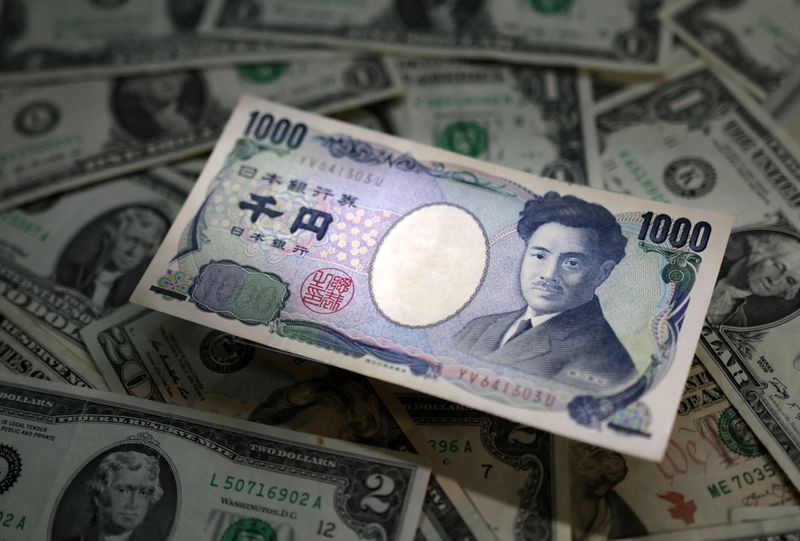
(Reuters) – The Japanese yen jumped by the most since late 2022 on Thursday, in a move traders said was most likely the result of dollar selling after a weak reading of U.S. consumer inflation, rather than official intervention from Tokyo authorities.
The dollar dropped by as much as 2.5% against the yen, set for the biggest daily decline since late 2022, when the Bank of Japan stunned markets with a surprise tweak to its monetary policy programme. It had intervened to prop up the yen for the first time since 1998 a few weeks before.
COMMENTS:
MARC CHANDLER, CHIEF MARKET STRATEGIST, BANNOCKBURN GLOBAL FOREX, NEW YORK
“I’d be surprised if they are, partly because of the time zone and partly because the dollar is responding to fundamentals as we would expect – softer CPI, lower U.S. rates, and of course dollar/yen falls… I think the market got caught leading the wrong way.”
“I think there’s three broad conditions. Volatility, and volatility is not very high, it wasn’t going into today. Secondly, I think they care about a one-way market, and it hasn’t been really a one-way market for a couple of weeks. And thirdly, I think about how the dollar reacts to fundamentals, and this is responding in line with fundamentals. So, the three broad criteria I don’t think are met.”
GIUSEPPE SERSALE, PORTFOLIO MANAGER, ANTHILIA, MILAN
“The yen is currently making fireworks. Honestly, I couldn’t say exactly what’s driving it. If the movement persists, it could mean that short-term positioning was too skewed towards short yen. And this US data created a situation where there was a violent rebound and a series of stop losses for those short on yen.”
“If, however, the movement deflates, halves during the day, or becomes very erratic, it means there was also a contribution from the Japanese Treasury, who at this moment doesn’t admit it… the move however seems excessive since the euro is gaining half a point, the pound is gaining half a point, and so on. Therefore, I have the impression that there is also a bit of contribution from the Japanese.”
AMES MALCOLM, HEAD OF FX STRATEGY, UBS LONDON:
“My personal guess is that this is not intervention.”
“The thing is the market position is so, so extended that it can feed on itself very, very easily, Regardless of whether you think it should be stabilising, if dollar-yen is dropping and you’re long, you have to get out… that’s the definition of a classic carry unwind.”
“There is an incentive to perhaps to do a little bit of intervention later in the day to ensure it doesn’t rebound.”
KENNETH BROUX, HEAD OF CORPORATE RESEARCH FX AND RATES, SOCIETE GENERALE
“It’s certainly a big move but I don’t think we can say it’s anything to do with intervention,” said Societe Generale (OTC:SCGLY)’s head of corporate research FX and rates Kenneth Broux.
“The US CPI has been a trigger and it’s more about stops being triggered than intervention,” he said.
STEVE ENGLANDER, HEAD, GLOBAL G10 FX RESEARCH AND NORTH AMERICA MACRO STRATEGY, STANDARD CHARTERED BANK NY BRANCH, NEW YORK
“Obviously the yen story has been a rate differential story and positions – long dollar/yen positions – have piled up. So when you get a number that’s this definitive in terms of making, say, September highly probable and kind of reinstating the disinflation story, that rate differential story erodes. Most likely it was cleaning up of positions because my sense from clients, especially short-term traders, is that everybody had some long dollar/yen on that they were thinking that maybe 165 or higher was kind of where it was headed.”
“There’s some vague speculation on intervention, just everybody’s looking at the price chart and kind of saying, oh, that’s, kind of a sharp drop so maybe could have it been. The answer is it could have, but I’d say most likely its position squaring rather than any official moves.”
LEE HARDMAN, SENIOR FX STRATEGIST, MUFG, LONDON
When the market is heavily positioned in one direction and then it goes the other way it can trigger this kind of abrupt move. Dollar/yen long positioning was very stretched
COLIN ASHER, SENIOR ECONOMIST, MIZUHO, LONDON
“Most likely, it’s just short covering, as speculation of US rate cuts on the horizon build in the wake of the negative CPI print.”

“USD/JPY is the G10 pair where positioning is most stretched.”
“It’s certainly a sizable move, with the intra-day range the biggest since the intervention at the start of May.”
This post is originally published on INVESTING.




